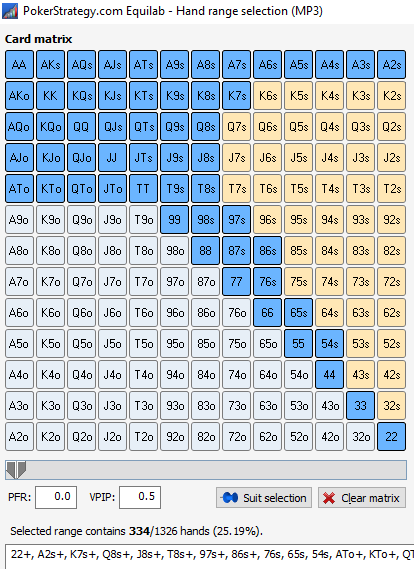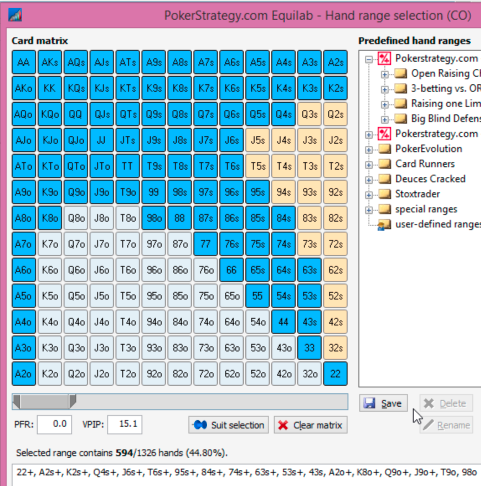We can find a basis for 's range space first by finding a basis for the column space of its reduced row echelon form. Using a calculator or row reduction, we obtain for the reduced row echelon form. The fourth column in this matrix can be seen by inspection to be a linear combination of the other three columns, so it is not included in our basis. Flopzilla: Range analysis software Flopzilla is a poker calculator that has been designed to let you quickly and easily figure out how a range hits a board. Just enter a preflop range and a board and Flopzilla will work out for you how often that range hits hands like top pair, middle pair, a flushdraw, a gutshot, etc.

I didn’t consider implementing poker ranges in my first few years of playing poker. One of the problems I used to experience at the tables was what to do with hands that weren’t so obviously strong (AA, AK – raise, raise, raise!) or so obviously weak (27o, J4o – ditch ‘em faster than green grass through a goose). Hands like K9o and 86s always gave me pause when it was folded to me. “Should I open… limp… or just fold?” I’d have to ask myself these questions all the time.
The answer to this problem was to create my own poker ranges. Bringing my off-the-felt analysis to on-the-felt play simplifies the game and ensures I’m making good opening hand decisions.
Finding ranges made by others online can help as a start, but they need to be tweaked and analyzed to fit your games and stakes. You can incorporate your own play style and the population tendencies at your stakes, with your own experiences and hand histories to help guide you in creating them.
The Poker Ranges You’ll Need
Here are the ranges that you’ll have to devise for the current stakes and games you play:
- Opening Ranges – Know what hands you’ll open in various positions (cash and MTT/SNG) as well as at different levels of the MTT/SNG (Early Stages, Mid-Stages, Late Stages).
- 3betting Ranges – You need to know which opponents you’ll 3bet and what you’ll 3bet with, both for value and as semi-bluffs.
- 4betting and 3bet Defending Ranges – Same considerations as your 3bet range.
The Importance of Building Ranges
There are three main reasons why we’d want to build ranges:
- Simplification – by creating ranges that we drill into our heads, we’ve simplified our game. We’ve put these common spots into our unconscious competence, so we can act without thinking. We’re letting our subconscious mind direct our plays, so our conscious mind has more resources to devote to analyzing more difficult, less common situations. This has the added benefit of allowing for more multi-tabling, which in turn will increase your hourly.
- Comfort – with your subconscious making decisions for you, you’ll be more comfortable and feel less stress at the tables. You’ll be more likely to avoid tilt and can continue playing longer sessions. Stress at the tables can lead to poor decisions, and making your subconscious work for you will be a great stress reliever.
- Bringing off-the-felt analysis to on-the-felt play – by spending time off-the-felt, creating a thoughtful range that takes into account your position, blind structure and opponent type, you’ll be able to bring your stress-free analysis of the game onto the felt. How many times have you reviewed a hand history and thought, ‘Why did I fold TT? It’s obvious he’s opening 30%+, and TT dominates him!’ When you’re working on your game off-the-felt, you’re doing so without the stress of in-game play, which allows for more clear and level headed thought. You can spot patterns and weaknesses easier off the felt. Creating your ranges then using them in-game is a way to bring your level-headed, stress-free thoughts from off-the-felt analysis to on-the-felt play.
How to Create Your Poker Ranges
Start by building your own hand table in Excel (or just download this one that I built) like the following example (6-max Mid-level Open Ranges of a micro stakes SNG):
Different colors divide ranges into sub-ranges. For example with Opening Ranges:
- Use one color for your default opening range (dark blue in the example above)
- Utilize another color (green) for an expanded range when there are fish in the blinds
- Use another color (yellow) for an even more expanded range when there are nits in the blinds
- You can use as many colors as you want to differentiate ranges. You can even toss in some bluffs vs regs (red) if you feel it necessary.
Range Matrix Poker Strategy

Don’t try to memorize the ranges you build. Constant use will help to naturally ingrain them in your Unconscious Competence. Just print, laminate and have at the ready as you play online, and eventually you’ll end up memorizing them (or make flash cards to ensure they get in that noggin quicker).
Consider your opponent’s ranges

When creating your Opening Ranges, you’ll have to have a good idea of what your opponents will likely call or re-raise with. For 3betting Ranges, you’ll have to be aware of what your opponents are likely opening with and what they’ll continue with. And for your 4betting and 3bet Defending Ranges, you’ll have to have a good sense of what your opponents 3bet with and what they’re likely to continue in the hand with. This exercise takes plenty of experience at your stakes. You’ll want to devote a week to creating your ranges, putting them to the test in your sessions and assessing the effectiveness of your ranges through hand history reviews. Then go back and adjust your ranges based on what you’ve found.
Using well thought out, strategic ranges like this won’t turn you into a robot; it will enable you to have an effective game plan to use vs. your opponent’s ranges. You will be bringing your off-the-felt intellect, problem solving skills and controlled emotions to your on-the-felt play.
How do I know my ranges are good?
You can do a few different things to test the precision of your ranges at your stakes and game type:
1. Use Flopzilla
This program gauges the effectiveness of each hand in your range vs. an expected opponent’s range. For example, how well does ATs on the BTN fair vs. a BB cold call range of 30%? “Oh, it has 62% equity? Yep, it’s an open.”
2. Review the Profitability of Specific Hands
Don’t know if A9s should be in your Cut-off open range? Run a filter in your poker tracking software for this hand (I use PokerTracker 4), and specifically when you Raised First-In with it in the CO. Review at least 20 hands in your history and ask yourself if this is an overall profitable hand to open with. Did you lose or win an unexpected amount with it? Do you often wind up with a kicker issue when called, or terrible equity when you call an opponent’s 3bet? Do the players at your stakes call with hands much weaker, allowing you to extract value from them post-flop?
3. Get Help from a Study Group or Forum
Post your ranges in the appropriate threads and solicit feedback. This is a more subjective way to check your ranges, but it could give you insights into aspects of your range that you never considered.
4. Get Feedback on Your Poker Ranges
Range Matrix Poker Tournaments
Your coach (or respected friends) will have plenty of thoughts on how your ranges would fare vs. your opponents, so use his feedback to adjust your ranges, test them on-the-felt, and make adjustments as necessary.
Poker Hand Range Matrix
After going through these four modes of feedback, put them into play. Once you’re confident in your ranges, laminate them and use them all the time. *Remember: When you move up in stakes, move to a new site or game format you’ll need to adjust your ranges.
It’s a time consuming process if you do it correctly, but well worth it. Try to enjoy the process, because as your skills increase and you progress through the levels, you’ll be revising your ranges over and over to account for the population tendencies of your new stakes. I hope this first time creating ranges leads to two, three, four, even five or more times for you!
Please share with me your own poker ranges by emailing them to sky@smartpokerstudy.com. I’d love to review them for you and offer you some feedback.

Until next time, study smart, play hard and make your next session the best one yet!
- The 12 Days of Christmas 2020 Podcast Episodes - December 14, 2020
- Strategies and Action Steps from the Quick Wins Poker Course - November 24, 2020
- How to Quickly Understand Online Tournament Players – Podcast #318 - November 18, 2020